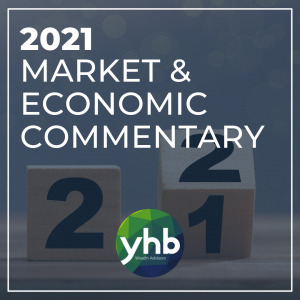
2021 Market and Economic Commentary
 The broad equity market turned in a solid performance in 2021 despite the ongoing waves and new variants of the coronavirus pandemic, historically high inflation, supply chain disruptions and political uncertainty. U.S. stocks finished the year by hitting fresh record highs, having posted their third consecutive year of solid gains thanks to a strong economic rebound that helped the market weather the challenges faced throughout the year.
The broad equity market turned in a solid performance in 2021 despite the ongoing waves and new variants of the coronavirus pandemic, historically high inflation, supply chain disruptions and political uncertainty. U.S. stocks finished the year by hitting fresh record highs, having posted their third consecutive year of solid gains thanks to a strong economic rebound that helped the market weather the challenges faced throughout the year.
The U.S. economy has been extremely resilient in the face of the challenges posed by shutdowns and limitations on business operations resulting from the government’s effort to combat the spread of Covid-19. The labor market recovery has been particularly notable. The U.S. has added 18.5 million nonfarm jobs since April 2020 and the number of people filing for unemployment claims recently reached a 52-year low. Dynamics have also swung in favor of workers over their employers and many working in consumer facing jobs, especially in the service industries, have been emboldened to quit their jobs at unprecedented rates or demand higher wages.
Another significant factor driving the equity market performance in 2021 has been the actions of the Federal Reserve. Throughout 2021, the Fed kept interest rates near zero and continued pumping billions of dollars into markets each month—measures that encouraged investors to seek out higher-returning assets, like stocks, but also contributed to higher inflation.
As we leave 2021 behind, some of the forces that propelled the equity markets to new highs may become signs of concern for 2022. Will consumer demand continue at the same torrid pace, will current elevated levels of inflation taper as we progress into the year, or will it persist or even rise further, and will the seemingly never ending and constantly changing Covid-19 related restrictions hamper economic growth?
Perhaps the most important question for 2022 is what impact the reversing of monetary support from the Federal Reserve, in the form of historically low rates and regular liquidity injections will have in the New Year. The Fed has announced plans to end its monthly bond-buying program by March 2022, and policymakers have indicated plans to increase the fed funds rate (i.e., interest rates) at least three times in 2022 to temper inflation.
As the Fed withdraws its support, investors will once again be required to focus more on whether the fundamentals that drive stock prices—the pace of economic growth and corporate earnings—can support another year of solid gains. If you have any questions, please feel free to contact us.
